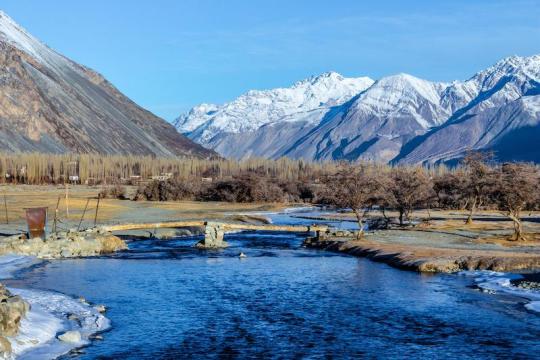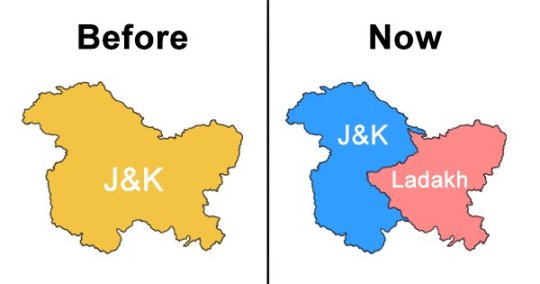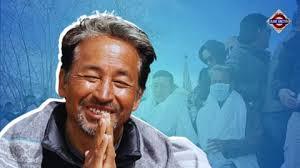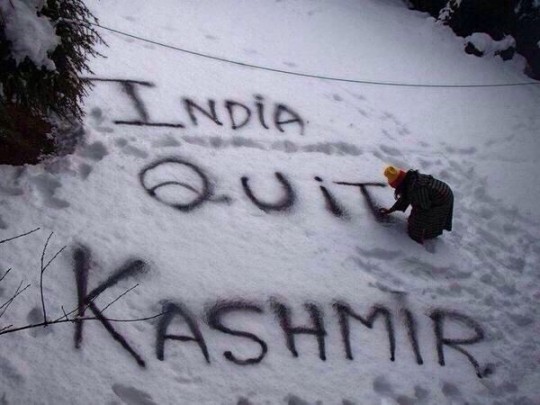#situation in Jammu and Kashmir
Text
IN CONVERSATION: An Interview With Maj Gen Sudhir Vombatkere On Army's Role In Internal Conflict Situations
In an interview with Kashmir Times, Major General Sudhir Vombatkere says that it is imperative that the army be held accountable for any violation of human rights and that transparency in investigations is paramount to ensure justice and maintain public trust. He averred, the army should not be misused in internal conflicts, as their primary role should be to safeguard the nation’s security…
youtube
View On WordPress
#Army should not be misused in Internal Conflict situations#Border districts of Rajouri and Poonch#Broader accountability lies with political leadership#Ensure justice and public trust#External Enemy and security#Human Rights Violations#Indian Army&039;s Deployment in Kashmir#Indian Army&039;s role to protect Country&039;s security#Jammu and Kashmir#Killing of three men in Rajouri-Poonch#Killing of three persons in Rajouri-Poonch in January#Misuse in Internal Conflicts#Prolonged Army&039;s deployment means failure of political establishment#Role of Indian Army in maintaining Human Rights#Transparency in Army&039;s Actions#Transparency in Investigations#Youtube
0 notes
Text
केन्द्रीय गृह मंत्री श्री अमित शाह ने आज नई दिल्ली में जम्मू-कश्मीर की सुरक्षा स्थिति पर समीक्षा बैठक की
केन्द्रीय गृह मंत्री श्री अमित शाह ने आज नई दिल्ली में जम्मू-कश्मीर की सुरक्षा स्थिति पर समीक्षा बैठक की
श्री अमित शाह ने इस साल अमरनाथ यात्रा के सफल आयोजन के लिए सुरक्षा एजेंसियों और केंद्र शासित प्रदेश जम्मू और कश्मीर प्रशासन के प्रयासों की सराहना की
केंद्रीय गृह मंत्री ने कहा कि प्रधानमंत्री श्री नरेंद्र मोदी के समृद्ध और शांतिपूर्ण जम्मू और कश्मीर के विजन को पूरा करने के लिए सुरक्षा बलों और पुलिस को सीमा व एलओसी को अभेद्य बनाने के लिए समन्वित प्रयास जारी रखना चाहिए
गृह मंत्री ने आतंकवाद का सफाया…

View On WordPress
0 notes
Note
Going Anonymous for security reasons here. So, regarding Kashmir: I am sick and tired of how people on Tumblr (or rather Hindublr tags) really believe that Kashmir is healing when it is still the most armed state in the world. I am horrified of how these people glorifying Army personels, who are no more than paid abusers and rapists and this is coming from a person whose family legacy is that of 'serving in the Army' I am not Kashmiri (And I cannot say I have faced the same shit they faced and I commend their resilience and their spirit) but I've had the chance to visit the 'non tourist' spots and let me tell you, it is fucked up. Even from the perspective of a person who is very privileged in this situation. I've literally seen some of these 'brave sons of India' beat up a seven year old boy just because he was 'being a hindrance in the road' One of my dad's colleague just got a 'warning' even after being a convicted assaulter after he raped two Kashmiri women (And this was back in 2013) and I came to know about this through Twitter out of all things. I remember going through those small towns in Kashmir and it being fucking empty and everything being closed up because they were afraid of the people who were stationed to 'protect' them. I am so sorry for venting out on your inbox like this but I've seen some of these blogs defend the Militarisation in Kashmir and it is awful and inhumane of how these people could even defend that out of all things. And to burst their bubble of delusion, it has gotten worse after the bill was passed. So many Kashmiri Muslims are getting wrongfully evicted out of their homes to 'house' the Pandits (but doing nothing when they were living as refugees and in destitution in Jammu) and the internet ban during the pandemic and people think Kashmir is healing?
And most of all, I wanted to thank you for posting the masterlist about Kashmir. It is very informative and has helped me learn and unlearn a lot of Kashmiri history.
This isn't even the first time the Army has done something like this. The IPKF was responsible for the massacres and rapes of multiple Tamil civilians it's insane how dedicated we are to glorifying the Indian military
#i know someone whose family legacy is also “serving in the army.” he wants to get in too...#anyways i'm glad you learnt something from that post nonnie!#asks#anon
22 notes
·
View notes
Text
On Sunday, Union Home Minister Amit Shah chaired a high-level security meeting on Jammu and Kashmir to review the security arrangements for the upcoming Shri Amarnath pilgrimage and the current security situation in Jammu following recent attacks.
Shah directed Jammu and Kashmir’s Lieutenant Governor Manoj Sinha and senior security officials to eradicate emerging terrorism in the Jammu region and ensure a robust security cover for the Yatra.
[…]
Shah also called for a multi-layered security plan for the Amarnath Yatra, which will run from June 29 to August 19, to ensure the safety of all pilgrims. The meeting discussed measures to secure tourist spots and prevent potential militant attacks.
10 notes
·
View notes
Text
Bollywood Movie Recommendations!
1.Sardar Udham

Length: 2h 42minute
Genre: Thriller, Crime, Biographical
Plot: Indian Revolutionary Udham Singh wants to avenge those lost in Jallianwala Bagh Massacre.
Starring: Vicky Kaushal, Banita Sandhu, Amol Parashar, Kristy Averton, Shaun Scott.
Notes from me: The acting done by Vicky Kaushal as the titular character is absolutely phenomenal and just tugs at your heartstrings, also the last 40 minutes are absolutely tear jerking.
2. Jaane Tu... Ya Jaane Na

Length: 2h 35 minutes
Genre: Rom-Com, Slice-of-life
Plot: BEST FRIENDS TO LOVERS!!! Two bestfriends Jai and Aditi are obliviously in love with each other until they start dating other people.
Starring: Genelia D’Souza, Imran Khan, Ratna Pathak Shah, Prateik Babbar
Note: COMFORT MOVIE!!!! I love absolutely everything, the connection between the friends, THE SOUNDTRACK!!
3. Zindagi Na Milegi Dobara

Length: 2h 30 minutes
Genre: Road trip, Comedy
Plot: Three friends Imran, Arjun and Kabir go on a road trip across Spain, before Kabir’s wedding and find imperfect flaws in their life, make decisions with the help of these friends and guide their way through life
Starring: Farhan Akhtar, Hritik Roshan, Abhay Deol, Kalki Koechlin, Katrina Kaif
Note: love!! once again a comfort movie, leaves you feeling refreshed and wanting to go on a cross country road trip with yout friends!
3. Haider

Length: 2h 40 minutes
Genre: Drama, Thriller, Action
Plot: An adaptation of the Shakespearean play Hamlet set in modern day Jammu & Kashmir. Haider returns to Jammu & Kashmir to find closure for his father’s death, but the states’ politics situation overpower him.
Starring: Shahid Kapoor, Tabu, Kay Kay Menon, Irrfan Khan
Note: A great movie which does not just portray Kashmir as this “beautiful picturesque scenery” but the harsh political reality of this fractured state, which is not easy to portray. This, in my opinion is one of the best acting performance of Shahid Kapoor’s career. Tabu as always SHINES (she should be stored in a gold vault istg), Kay Kay Menon steals the show with his perfectly sinister portrayal of Haider’s Uncle.
4. Kapoor & Sons

Length: 2h 12 minutes
Genre: Drama, Slice-Of-Life
Plot: Two brothers Arjun and Rahul return home to Conoor to visit their ailing Grandfather. During this stay the entire family discovers just how dysfunctional and fractured their relationships are.
Starring: Fawad Khan, Sidarth Malhotra, Rishi Kapoor, Ratna Pathak Shah, Rajat Kapoor
Note: Albeit a slow 20 minutes in the start, the movie really engages you and makes you uncover the aspects of the Kapoor family with them and makes you realise just how broken and tired of the façade of happiness they truly are.
6. Guzaarish

Length: 2 hours
Genre: Drama, Romance
Plot: Former renowned magician Ethan Mascarenhas is quadriplegic and expresses his guzaarish (request) for euthanasia.
Starring: Hritik Roshan, Aishwariya Rai, Aditya Roy Kapur
7. Andhadhun

Length: 2h 18 minutes
Genre: Thriller, Crime, Comedy
Plot: Akash, a piano player pretending to be visually-impaired, unwittingly becomes entangled in a number of problems as he witnesses the murder of a former film actor
Starring: Ayushmann Khurrana, Tabu, Radhika Apte, Manav Vij
Note: TABU!!! Her portrayal of Simi, the wife of the film actor is so good and entrancing. Ayushmann in the film’s climax shines. The plot twists are chefs kiss.
#sardar udham#jaane tu ya jaane na#haider#kapoor and sons#guzaarish#andhadhun#vicky kaushal#imran khan#genelia d souza#shahid kapoor#TABU#fawad khan#sidharth malhotra#ratna pathak shah#radhika apte#I LOVE ALL OF THESE MOVIES SM#desi#desiblr#desi movie recs#bollywood movie recommendations
220 notes
·
View notes
Text

Pangong Lake, situated at an elevation of approximately 4,350 meters (14,270 feet) above sea level, is a mesmerizing high-altitude lake located in the Ladakh region of the Indian state of Jammu and Kashmir. Renowned for its stunning beauty and surreal surroundings, Pangong Lake is a popular tourist destination and a must-visit attraction for travelers exploring the Himalayas.
https://hmtholidays.com/st_tour/fly-leh-ladakh/?date=11/03/2024%2012:00%20am-12/03/2024%2011:59%20pm
#travel#tourism#leh#ladakh#ladakhtrip#ladakhtourism#ladakhtourpackages#lehladakhpackage#lehladakhtrip#lehladakhgrouptourpackages#lehladakhtrippackages#pangong lake#ladakhtrippackages#lehladakh#ladakhtouristplaces#ladakhholidaypackages#ladakhtravelpackages#kashmirlehladakhtourpackage#lehladakhtourpackages#lehladakhtravelpackages#lehladakhkashmirtourpackages#lehandladakhpackage#kashmirlehladakhtrip#kashmirlehladakh#ladakhtouristdestinations#lehjammuandkashmir#pangong
4 notes
·
View notes
Note
In which world has India "occupied" Kashmir? Kashmir is a part of India which is severely affected by terrorist activity. Many were forced to leave their homes to settle in different parts of India (Kashmir pandits etc). How was that India's fault and not the fault of the country the terrorists came from?
Firstly, I want to make it clear that I do condemn what was done to Kashmiri Pandits. Secondly, I do believe that Kashmir is occupied (that does NOT mean that I don't understand that the geopolitical reality is complex), and that a plebiscite should have been conducted. And I believe that neither India nor Pakistan has been entirely innocent with regard to Kashmir.
My interpretation of the events described below (quoted from the linked articles), is that Kashmir is occupied. And no, they are not my only sources of information - other articles, the Kashmiri woman who came to speak at my university, and a friend of a friend who visited Kashmir and stayed there for a significant period of time (not as a tourist), are also sources of my information on Kashmir.
When India and Pakistan gained independence from British rule in 1947, the various princely rulers were able to choose which state to join.
The Maharaja of Kashmir, Hari Singh, was the Hindu head of a majority Muslim state sandwiched between the two countries and could not decide. He signed an interim "standstill" agreement to maintain transport and other services with Pakistan.
In October 1947 tribesmen from Pakistan invaded Kashmir, spurred by reports of attacks on Muslims and frustrated by Hari Singh's delaying tactics. The Maharaja asked for Indian military assistance.
India's governor-general, Lord Mountbatten, believed peace would best be served by Kashmir's joining India on a temporary basis, pending a vote on its ultimate status. Hari Singh signed the Instrument of Accession that month, ceding control over foreign and defence policy to India.
Indian troops took two-thirds of the territory, and Pakistan seized the northern remainder. China occupied eastern parts of the state in the 1950s.
Whether the Instrument of Accession or the entry of Indian troops came first remains a major source of dispute between India and Pakistan. India insists that Hari Singh signed first, thereby legitimising the presence of their troops. Pakistan is adamant that the Maharaja could not have signed before the troops arrived, and that he and India had therefore ignored the "standstill" agreement with Pakistan.
Pakistan demands a referendum to decide the status of Kashmir, while Delhi argues that, by voting in successive Indian state and national elections, Kashmiris have confirmed their accession to India. Pakistan cites numerous UN resolutions in favour of a UN-run referendum, while India says the Simla Agreement of 1972 binds the two countries to solve the problem on a state-to-state basis.
There has been no significant movement from these positions in decades. In addition, some Kashmiris seek a third option - independence - which neither India nor Pakistan is prepared to contemplate.
The two countries fought wars over Kashmir in 1947-48 and 1965. They formalised the original ceasefire line as the Line of Control in the Simla Agreement, but this did not prevent further clashes in 1999 on the Siachen Glacier, which is beyond the Line of Control. India and Pakistan came close to war again in 2002.
The situation was further complicated by an Islamist-led insurgency that broke out in 1989. India gave the army additional authority to end the insurgency under the controversial Armed Forces Special Powers Act (AFSPA). Despite occasional reviews of the AFSPA, it still remains in force in Indian-administered Jammu and Kashmir.
Today it remains one of the most militarised zones in the world. China administers parts of the territory.
Media in Indian-administered Kashmir are generally split between pro- and anti-secessionist. Local journalists work under strict curfews and also face threats from militant groups. Internet access is sporadic and text messaging services are regularly blocked.
In Pakistani-controlled Kashmir, the media are used mainly for propaganda purposes, mainly to highlight the alleged human rights violations in Indian-administered Kashmir.
Also, I think the following information is relevant too.
The Muslim majority in the princely state found the Maharaja’s reign authoritarian. In the words of Kashmiri author P.N. Bazaz, “Dogra rule has been a Hindu Raj.” Maharaja Hari Singh thought of independence because, according to American Indologist William Norman Brown, “He disliked becoming part of India, which was being democratised, or Pakistan, which was Muslim....”
On August 12, 1947, J&K petitioned India and Pakistan for a standstill agreement, which Pakistan signed but India refused, asking the Maharaja to send a representative for discussions. With every passing day, the Maharaja’s position became more precarious. As early as June 1947, about 60,000 ex-army men (mostly from Poonch) had started a no-tax campaign against the Maharaja. On August 14-15, Muslims in Poonch hoisted Pakistani flags, provoking the imposition of martial law and further angering Muslim subjects. Pakistan was sending warning notes to the Maharaja, one on August 24 reading: “Should Kashmir fail to join Pakistan, the gravest possible trouble will inevitably ensue.”
The worst fears of the Dogra ruler came true when on October 22, Pakistan launched Operation Gulmarg by mobilising tribals from the North-West Frontier Province. About 2,000 tribesmen, armed with modern weaponry, raided Muzaffarabad. By the evening of October 23 they had captured Domel. Garhi and Chinari fell over the next two days. Then their main column proceeded towards Uri, and then, along the Jhelum river towards Baramulla, the entry point to Srinagar.
On October 24, Maharaja Hari Singh appealed to India for military aid to flush out the raiders. India obliged but not before the Instrument of Accession was signed on October 26. It limited India’s powers over the Valley to matters of defence, communications, and foreign affairs.
And this is from the Instrument of Accession:
Nothing in this Instrument shall be deemed to commit in any way to acceptance of any future constitution of India or to fetter my discretion to enter into agreement with the Government of India under any such future constitution.
4 notes
·
View notes
Text
The Ladakh Protest: The 21-day Hunger Strike led by Sonam Wangchuk

Ladakh, famously known as “Mars on Earth”, is the perfect destination where the mind slows down and the soul finds its path.
It is the northeastern Union territory of India, known for its highest mountain ranges, mesmerizing landscapes, beautiful deep valleys, crystal clear blue lakes, diverse wildlife, highest motorable mountain roads, Buddhist heritage, and the overall picturesque beauty of the place.
Ladakh: A union territory without legislature

Ladakh, which was a part of Jammu and Kashmir since 1847, was separated from Indian-administered Kashmir in 2019 and was reconstituted as a Union territory on October 31, 2019.
People of Ladakh have constantly demanded separate territory since the 1930s due to the unfair treatment of Kashmir and the prevailing cultural differences between people of Kashmir and Ladakh.
The formation of Ladakh as a separate Union territory was widely celebrated. Still, people were disappointed because it was made a UT without a legislative assembly and would have a lieutenant governor, while Jammu and Kashmir had a legislature.
What does it mean to have no legislature in Ladakh?
Unlike J&K, Ladakh cannot elect its own representative.
Ladakh will be ruled directly by the central government through a lieutenant governor as an administrator.
The President of India has the power to form rules and regulations for Ladakh, according to Article 240.
Sonam Wangchuk following his Father’s footsteps
Sonam Wangyal was born in 1925 in a small village in the Leh district of Ladakh. He worked his entire life for the rights of the people of Ladakh. He had strong secular beliefs.
He was appointed as the MLC of Jammu and Kashmir from 1957–1967 and as the MLA from 1967–1972, due to his selfless service toward the people of Ladakh.
Wangyal was also an active member in the campaign for ST status for Ladakhis, which was carried out between 1982 and 1984.
In 1984, on his five-day hunger strike, the former Prime Minister, Indira Gandhi, visited Leh and requested Wangyal to withdraw from the strike with the promise of granting the status of ST to the people of Ladakh.

Following his father’s strong morals and values and showcasing his devotion to the land and people of Ladakh, Sonam Wangchuk, a nature activist, engineer, innovator, and educationalist, began a “climate fast for 21 days” on March 6, 2024.
Why are they protesting?
The primary goal behind the protest is to raise awareness about the fragile ecosystem of Ladakh endangered by the growing industrial and developmental projects approved in New Delhi without consent, a threat posed as a result of having no legislative assembly in the Union territory of Ladakh.

The residents of Ladakh have two key demands:
Full-fledged statehood for Ladakh: the residents have demanded to elevate Ladakh’s status as a Union territory to a full-fledged state. This would enable Ladakh to have its own government and the right to form its own rules and regulations in favor of the land and people of the territory.
Integration of Ladakh in the 6th Schedule of the Constitution: The 6th Schedule aims to protect areas with tribal and indigenous populations. By including Ladakh in the 6th schedule, it would allow the state to establish autonomous districts and regional councils.
These elected bodies will have the power to administer and protect the tribal regions of the area. It would give the Ladakhis more control over water management, land use, and cultural preservation.
What is the government’s response to the ongoing protest?
Unlike the response and action taken upon the hunger strike carried out by Wangchuk’s father, the present-day government is MIA.
The current government seems unbothered by the demands and protests in Ladakh, just the way it is, and the deteriorating situation in Manipur.
The pioneers of the movement and every other active citizen in and out of Ladakh are furious about the inaction of the government and the PM, who knowingly promised in his 2019 manifesto of Lok Sabha, that Ladakh will be incorporated into the 6th schedule of the constitution. But apparently, they failed to honor their promises.

Lack of media coverage:
The lack of media coverage is infuriating for the people of Ladakh and the active citizens of India.
Although the independent media and journalists who are physically present in the ongoing protests do cover the news for the country, But it is disappointing to witness the lack of coverage by mainstream media and the big houses.
The scarcity of coverage of this major issue conceals the truth from the nation. The nation wants to know more about the concerns and affairs of the territory. Unless there is some news from the local media houses, the lack of coverage by the recognized media houses keeps the common man from knowing what is really happening there.
The current news on the Ladakh protest:
According to the current news,
Wangchuk survived solely on water and salt during the 21-day hunger strike (inspired by Gandhiji), which lasted from March 6th to March 26th.
In his speech, he talked about the “21-day fast"—that 21 days was the longest fast that Gandhiji kept during the independence movement.
Wangchuk states that the 21-day fast is over, but the protest will still continue. They will only rest when the government agrees to fulfill their demands.
Wangchuk said, “After me, women will begin a 10-day fast tomorrow. This will be followed by youth and Buddhist monks. Then it could be women, or I could come back. This cycle will go on.”
After ending his 21-day fast, Wangchuk stated “We will continue our struggle (in support of our demands). The gathering of 10,000 people at the venue and the participation of over 60,000 others over the past 20 days is a testimony of the people's aspirations.”
Conclusion:
All things considered, Ladakh, the "Land of High Passes," stands at a crossroads. While the echoes of their protests might fade from national headlines, the Ladakhi people's yearning for a brighter future persists.
Whether they find resolution in the sixth schedule status or the full-throated roar of statehood, one thing is certain: Ladakh's story is far from over.
2 notes
·
View notes
Text
Top 10 Best places to travel in india

Top ten Best places to travel in india
Taj Mahal, Agra: The Taj Mahal is a world-famous white marble mausoleum located in Agra, Uttar Pradesh. It was built by Mughal Emperor Shah Jahan in memory of his wife Mumtaz Mahal and is considered one of the most beautiful buildings in the world.
Rishikesh, Uttarakhand: Rishikesh is a spiritual city located in the foothills of the Himalayas in Uttarakhand. It is known for its serene beauty and is considered the "Yoga Capital of the World." It is also a popular destination for adventure sports like rafting and trekking.
Varanasi, Uttar Pradesh: Varanasi, also known as Benares or Kashi, is one of the oldest cities in the world and is considered a holy city in Hinduism, Buddhism, and Jainism. It is situated on the banks of the River Ganges and is famous for its ghats, temples, and spirituality. varanasi is one of the Best places to travel in india
Goa: Goa is a state on the west coast of India known for its stunning beaches, unique blend of Indian and Portuguese culture, and relaxed atmosphere. It is a popular destination for beach lovers, party-goers, and those seeking relaxation.
Kerala: Kerala is a state in southern India known for its lush tropical landscapes, serene backwaters, and delicious cuisine. It is a popular destination for those seeking relaxation and natural beauty, as well as those interested in Ayurvedic treatments and yoga.
Darjeeling, West Bengal: Darjeeling is a town located in the foothills of the Himalayas in West Bengal. It is known for its tea plantations, stunning views of the Himalayas, and colonial architecture. It is a popular destination for those seeking a peaceful retreat in the mountains.
Udaipur and Jaipur, Rajasthan: Udaipur and Jaipur are two cities located in the state of Rajasthan known for their rich history, stunning palaces, and vibrant culture. Udaipur is known as the "City of Lakes" and is famous for its beautiful lakes and palaces, while Jaipur is known as the "Pink City" and is famous for its pink-hued buildings and forts.
Hampi, Karnataka: Hampi is an ancient city located in the state of Karnataka. It was once the capital of the Vijayanagara Empire and is now a UNESCO World Heritage site known for its stunning ruins, temples, and monuments.
Khajuraho, Madhya Pradesh: Khajuraho is a small town located in Madhya Pradesh known for its stunning temples with intricate carvings depicting human sexuality, mythology, and daily life. The temples are a UNESCO World Heritage site and attract visitors from all over the world.
Ladakh, Jammu and Kashmir: Ladakh is a region located in the northernmost state of Jammu and Kashmir. It is known for its stunning landscapes, high-altitude mountains, and unique culture. It is a popular destination for adventure sports like trekking and rafting, as well as those seeking a peaceful retreat in the mountains.
#Best places to travel in india#Top 10 Best places to travel in india#Top ten Best places to travel in india#newsaajkal
2 notes
·
View notes
Text
Context: Indian government has decided to begin weather forecasts for regions under Pakistan-occupied Kashmir (PoK) — Gilgit-Baltistan, Muzaffarabad and Mirpur.
After DD and AIR started airing weather forecasts from PoK regions, In return Radio Pakistan also featured updates from Srinagar, Pulwama and Ladakh.
What’s the issue?
The ‘weather war’ — a diplomatic move by India — started after Pakistan’s Supreme Court issued notices to the advocate general of Gilgit-Baltistan in late April, directing them to amend the Gilgit-Baltistan Order-2018 and establish a caretaker government there.
About PoK:
Pakistan Occupied Kashmir (PoK) is that part of the Jammu and Kashmir (India) which was invaded by Pakistan in 1947. The region is referred by the United Nations and other international organizations, as ‘Pakistani-controlled Kashmir’ (or Pakistan Administered Kashmir) and it was re-named as ‘Pakistan occupied Jammu-Kashmir’ by the Modi government.
PoK divided into two parts:
Azad Jammu and Kashmir (AJK)
Gilgit-Baltistan (referred to as the ‘Northern Areas’ till August 2009).
What is the root of the fight between India and Pakistan?
The fact that PoK is an integral part of India has been our consistent policy ever since 1947.
In 1947, Pakistan’s Pashtoon tribals attacked Jammu and Kashmir.
So to tackle this critical situation the Ruler of that time Maharaja Hari Singh of Jammu and Kashmir sought military assistance from the Indian government and the then Indian Governor General Mountbatten signed an agreement on 26 October 1947 in which three subjects Defense, Foreign Affairs and Communications were handed over to India.
Except these subjects Jammu and Kashmir was free to all its decisions.
On the basis of this accession of treaty, the Government of India claims that India has the full right to interfere in the matters related to Jammu and Kashmir. Pakistan on the other hand doesn’t agree with India.
Why is PoK important?
Because of its location, PoK is of immense strategic importance. It shares borders with several countries – the Punjab and North-West Frontier Province provinces (now called Khyber-Pakhthunkhwa) in Pakistan to the west, the Wakhan Corridor of Afghanistan in the north-west, Xinjiang province of the People’s Republic of China to the north and India’s Jammu and Kashmir to the east.
Challenges for India in PoK region:
Terrorist infiltration through the region is high.
Pakistan has changed the demography of PoK over a period of time.
It has settled ex- servicemen, Punjabi’s and Pathans so the original colours of PoK has changed.
Gilgit Baltistan region is easy as compared to other.

#india gdp latest news#indian#tumblog#tumbloadr#illustrators on tumblr#illustration#dailymail#lgbtq#news#world news#pok#pakistan#economy#viral stories#february 2023
3 notes
·
View notes
Text
How To Plan A Trip To Chiranbal – An Unfathomed Jewel
In this article we are covering one of the biggest sub alpine and unexplored meadows of Kashmir “How To Plan A Trip To Chiranbal – An Unfathomed Jewel “. You are all aware of Kashmir’s key attractions, stunning locations, and breathtaking vistas which includes Sonamarg, Gulmarg, Pahalgam, Doodhpathri, and many more. However, you might not be aware of some beautiful destinations that I personally think are more beautiful and are far from other tourist attractions.
There are some hidden gems in Kashmir that no one talks about and probably have no information about, such as some lakes, meadows, and many more hill stations. And many of those beautiful places with stunning views are situated in the Kulgam district of Jammu and Kashmir.
Chiranbal Meadow
When we talk about tourist attractions in Kulgam, we only mention Aharbal, Kongwattan, and Kousarnag. Beyond this is an unknown world that most of us do not know about. The world I’m referring to is a hidden gem in Aharbal’s surroundings. Along with the Pir Panjal range in Kulgam, there are numerous treks that lead to beautiful meadows, attractive peaks, numerous rivers and lakes. Nature has bestowed great scenic beauty on the Noorabad region. Everything is stunning, from Pari Top (Sondir Top) to Kounsarnag. To learn more please visit:

#kashmir#travel#srinagar#youtube#travel photography#tourism#photography#world#education#meadow#lakeview
2 notes
·
View notes
Text
15 Famous Temples in India Everyone Should Visit
India is known for its temples — beautiful, serene places of worship — significant religious and historic landmarks.
These ancient, intricately designed, and faithfully maintained places of worship are a must-visit for devotees and for all those who nurture an interest in history and architecture. Here are the fifteen most famous temples in India.
1. Golden Temple, Amritsar
Also known as Harmandir Sahib, this gorgeous temple is the holiest place of worship for the Sikh religion, and one of the most famous temples in North India. Built in the mid-15th century on the banks of a man-made lake in Amritsar, this temple’s golden facade and religious significance are a huge draw, and see devotees and tourists alike, arrive at its doors throughout the year in significant numbers.
2. Tirupathi Balaji, Tirumala
Officially known as the Venkateshwara Temple, this hill-top temple is dedicated to Lord Venkateshwara, who is a manifestation of Lord Vishnu. This temple, along with its beautiful infrastructure, also has the distinction of being the richest Hindu temple in the world.
3. Maa Vaishno Devi Temple, Katra
Located in the foothills of the mighty Himalayas in Jammu and Kashmir, Vaishno Devi is one the most important temples in India. Lakhs of devotees undertake the pilgrimage to this temple every year to pay their respects to Goddess Vaishnavi, the patron deity of this temple.
Reaching the temple requires a 12 km trek. Devotees have multiple options ranging from walking to riding a horse or even a helicopter among others to get to the top.
4. Jagannath Temple, Puri
One of the oldest temples on this list, Jagannath Puri dates to the 12th century and is a temple dedicated to Lord Vishnu. Apart from being a spectacular architectural edifice and one of the char dhams of Hindu religion, it is also famous for the elaborate rath yatra it hosts every year.
5. Meenakshi Temple, Madurai
The Meenakshi Temple took its current, grandiose form in the 12–13th century, but it has been a place of worship for much longer than that. Located in the heart of Madurai, this sprawling temple is dedicated to Goddess Meenakshi (an incarnation of Parvati). Its wide hallways are always packed with devotees, and the three-storey gopuram or entrance tower over its gate is exceptionally iconic.
6. Ramnathswamy Temple, Rameshwaram
Located off the coast of India on the Pamban Island, this is another temple that is part of the holy char dham. The temple was built in its current form in the 12th century. Dedicated to Lord Shiva, this is one of the most famous temples in South India.
7. Virupaksha Temple, Hampi
This famous temple can be found in the UNESCO World Heritage temple town of Hampi in Karnataka. The temple is dedicated to Lord Virupaksha, an avatar of Lord Shiva, and dates to the 7th century. One of its most significant elements is its nine-storey gopuram which is nearly 165 feet in height. Steeped in a legacy of tradition and surrounded by relics from ancient times, this temple is the jewel in one of India’s most significant historical crowns.
8. Kashi Vishwanath Temple, Varanasi
This famous temple is one of the most attractive places of worship in the holy city of Varanasi. Situated on the banks of the River Ganga, Kashi Vishwanath is dedicated to Lord Shiva. The temple is also located right next to the Dashashwamedh Ghat, arguably the most significant ghats in the area. The renowned Ganga Aarti takes place here every evening.
9. Badrinath Temple, Uttarakhand
In the town of Badrinath, surrounded by the Garhwal Hills you will find the Badrinath Temple. Third of the char dhams on this list, Badrinath Temple is dedicated to Lord Vishnu. Its stone fascia and shimmering gilded roof make it one of the most recognisable temples in India. The momentous Mata Murti Ka Mela is celebrated at this temple as well.
10. Lingaraja Temple, Bhubaneshwar
Lingaraja Temple is one of the oldest temples in Bhubaneshwar and one of the most sizeable temples in town too. The temple’s main tower is 180 feet tall, and the origins of this ancient Indian temple date back to the 700th century.
11. Konark Sun Temple, Konark
This legendary temple favours Surya, the sun god, and hosts the famous Chandrabhaga festival in February every year. A good 100 feet tall, this temple was built to look like a chariot back in the year 1250. Though it has suffered some damage and deterioration, it is still a magnificent structure to visit.
12. Dwarkadeesh Temple, Dwarka
Another one of the char dham, this temple dates back over 2000 years. Lord Krishna is the revered deity here, and the primary shrine is a five-storey building built on 72 pillars. Legend states that this temple has been built on the very site of Lord Krishna’s mythical palace.
13. Brihadeeshvara Temple, Thanjavur
Another temple that’s located in the south Indian state of Tamil Nadu, Brihadeeshvara is an icon of the Chola Dynasty. This temple is ancient too, built way back in the period spanning 1003–1010 AD. You will also find one of the largest Shiva lingam in India within this temple.
14. Padmanabhaswamy Temple, Thiruvananthapuram
In the capital of Kerala state you can find the storied Padmanabhaswamy Temple. The city of Thiruvananthapuram actually gets its name from this temple, dedicated to Lord Anantha. Another interesting fact about the temple is that the Royal Family of Travancore has always been entrusted with its care.
15. Somnath Temple, Saurashtra
Another temple found in Gujarat, Somnath is an ancient place of worship. So much so that historians have been unable to trace how long ago the first temple was established at this site. The temple has been destroyed and rebuilt a few times in its history, with the latest iteration being put in place in 1951, and has become one of the most famous Hindu temples in India since.
Read the more amazing blog on the Evergreen Club website blog section, an online community for senior citizens.
2 notes
·
View notes
Text
HST Him Vlogs @himhp
In19thcentury century, Ranjit Singh annexed/subjugated many of the states. When the British came, they defeated Gorkhas entered into treaties with some Rajas, and annexed the kingdoms of others. The situation more or less remained unchanged till 1947. After #independence 30 princely states of the area were united, and Himachal was formed on #15th April 1948. With the recognition of Punjab on 1st November 1966, certain areas belonging to it were also included in Himachal Pradesh. The state was made a full-fledged State on 25 January 1971. The state is bordered by Jammu & Kashmir on the North, Punjab on the West and South-West, Haryana on the South, Uttarakhand on the South-East and China on the East.#शिमला हिमाचल प्रदेश की राजधानी है। शिमला पहड़ों की रानी के नाम से भी जाना जाता है। शिमला और सोलन के किसान कृषि और बागवानी का व्योसाय करते हैं।संस्कृति, खान पान, नृत्य हर जिला के अलग अलग होते हैं, शादी के गीत भी हर जिला के अलग होतें हैं पर मिलते जुलते होते हैं#Himalayan Highs: The HST Vlog#himachal
0 notes
Text
Discover the Magnificence of Lord Shiva Temples in India

India, a land of diverse cultures and ancient traditions, is home to numerous temples that have stood the test of time. Among these, the Lord Shiva temples in India hold a special place. Devotees from all over the world flock to these sacred sites to seek blessings from the Destroyer of the Universe, as per Hindu mythology. Let's embark on a spiritual journey to explore the most revered Lord Shiva temples in India.
1. Kedarnath Temple: A Journey to the Divine
Located in the Garhwal region of Uttarakhand, Kedarnath Temple is one of the most prominent Lord Shiva temples in India. Nestled in the lap of the majestic Himalayas, this temple is part of the Char Dham Yatra and is considered one of the twelve Jyotirlingas. The trek to Kedarnath is a challenging yet profoundly rewarding pilgrimage, offering breathtaking views and an unmatched sense of serenity.
2. Varanasi’s Kashi Vishwanath Temple: The Eternal Abode
Kashi Vishwanath Temple, situated in the ancient city of Varanasi, Uttar Pradesh, is one of the most significant Lord Shiva temples in India. This temple, dedicated to Vishwanath or the "Ruler of the Universe," is located on the banks of the sacred river Ganges. Pilgrims believe that a visit to this temple and a dip in the holy Ganges can liberate one from the cycle of birth and death.
3. Somnath Temple: The First Among the Twelve Jyotirlingas
Somnath Temple, located in the Prabhas Kshetra near Veraval in Gujarat, is revered as the first of the twelve Jyotirlinga shrines of Lord Shiva. This temple has a rich history and has been destroyed and rebuilt several times, standing as a testament to the resilience of faith. The temple's exquisite architecture and its stunning location by the Arabian Sea make it a must-visit.
4. Rameshwaram’s Ramanathaswamy Temple: A Pilgrimage of Legends
Ramanathaswamy Temple, located on Rameshwaram Island in Tamil Nadu, is one of the most significant Lord Shiva temples in India. It is believed to be the place where Lord Rama worshipped Shiva to absolve his sins after defeating Ravana. The temple is renowned for its magnificent corridors, massive sculpted pillars, and 22 holy wells (theerthams) where pilgrims perform sacred rituals.
5. Amarnath Cave Temple: The Mystical Ice Lingam
Amarnath Cave Temple, situated in the union territory of Jammu and Kashmir, is one of the most revered Lord Shiva temples in India. The temple is famous for the naturally occurring ice lingam, which is believed to be a physical manifestation of Lord Shiva. The challenging trek to the cave, through rugged terrain and snow-covered paths, is undertaken by thousands of devotees every year during the annual Amarnath Yatra.
6. Mahakaleshwar Temple: The Lord of Time
Located in the ancient city of Ujjain in Madhya Pradesh, Mahakaleshwar Temple is another important Jyotirlinga shrine among the Lord Shiva temples in India. This temple is unique because it houses one of the few Dakshinamurti idols, where Shiva is depicted facing south. The temple's Bhasma Aarti, a ritual where the deity is worshipped with sacred ash, is a spectacular event that draws devotees from all corners of the country.
Conclusion
The Lord Shiva temples in India are not just places of worship but are also embodiments of India's rich cultural heritage and spiritual legacy. Each temple, with its unique history and architectural splendor, offers a profound spiritual experience to the devotees. Whether you seek divine blessings, solace, or simply want to immerse yourself in the rich traditions, these temples provide a perfect retreat.
Exploring these magnificent Lord Shiva temples in India is a journey that every devotee should undertake at least once in their lifetime. At Our Temples, we believe in preserving and promoting the rich spiritual and cultural heritage of India. Join us in this sacred journey and experience the divine presence of Lord Shiva in these majestic temples.
0 notes
Text
New Delhi: In his first remarks on the ongoing Lok Sabha elections, Mirwaiz Umar Farooq has said that the Hurriyat was “not against the idea of elections” in Jammu and Kashmir but linking it to the resolution of the Kashmir issue.
Mirwaiz, who is also the chief cleric of Kashmir, said that this time around the Hurriyat hasn’t issued a boycott call against the election, as it did in the past, because of “serious alterations in the ground situation” following the reading down of Article 370 by the BJP-led Union government in 2019. “Under these changed circumstances, issuing a boycott call, unlike before 2019, does not seem to carry the sense and effect that it did before. Besides, the people of J&K, baptised by fire from decades old conflict, have gained enough political maturity and wisdom to know what best to do in the current situation,” he said.
The moderate Hurriyat leader, who was again put under house arrest on Friday, May 3, and prevented from delivering the sermon at the historic Jamia Masjid, made these remarks in an interview with Reuters.
9 notes
·
View notes
Text
Latest News Today Live: Amid terror attacks in J-K, Amit Shah to review security situation ahead of Amarnath yatra | India News
New Post has been published on https://petn.ws/KFppF
Latest News Today Live: Amid terror attacks in J-K, Amit Shah to review security situation ahead of Amarnath yatra | India News
Latest News Today Live: A day after reviewing the security situation in Jammu and Kashmir in the wake of recent terror attacks, Union Home Minister Amit Shah is expected to provide broad guidelines on intensifying counter-terror operations in the Union Territory in a high-level meeting today. Terrorists struck at four places in Reasi, Kathua and Doda […]
See full article at https://petn.ws/KFppF
#OtherNews
0 notes